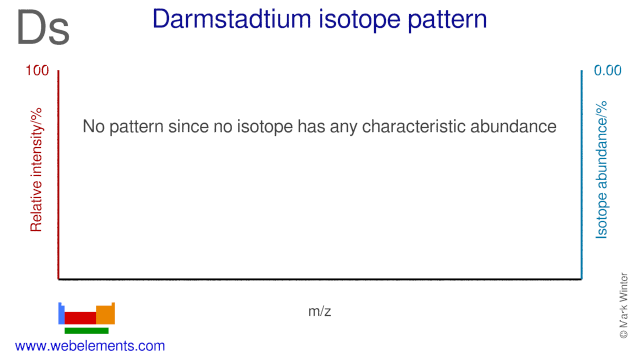Darmstadtium - 110Ds: the essentials
- Name: darmstadtium
- Symbol: Ds
- Atomic number: 110
- Relative atomic mass (Ar): [ 281 ] (longest lived isotope)
- Standard state: presumably a solid at 298 K
- Appearance: unknown, but probably metallic and silvery white or grey in appearance
- Classification: Metallic
- Group in periodic table: 10
- Group name: (none)
- Period in periodic table: 7
- Block in periodic table: d
- Shell structure: 2.8.18.32.32.17.1
- CAS Registry: 54083-77-1
Darmstadtium atoms have 110 electrons and the shell structure is 2.8.18.32.32.17.1. The ground state electronic configuration of neutral darmstadtium is [Rn].5f14.6d9.7s1 (a guess based upon that of platinum) and the term symbol of darmstadtium is 3D3 (a guess based upon guessed electronic structure).
Darmstadtium: description
Darmstadtium, is a synthetic element that is not present in the environment at all. The interested reader should consult the on-line version of Creating Super Heavy Elements for a fascinating insight into research on "super-heavy" atoms.
Chemically, darmstadtium is in the same Group as nickel, palladium, and platinum (Group 10). Unlike these lighter atoms, darmstadtium decays after a small fraction of a thousandth of a second into lighter elements by emitting α-particles which are the nuclei of helium atoms.
Darmstadtium: physical properties
Density of solid: 27400 (predicted) kg m-3
Molar volume: 10 (rough estimate based upon density estimate) cm3
Thermal conductivity: (no data) W m‑1 K‑1
Darmstadtium: heat properties
Melting point: (no data) K
Boiling point: (no data) K
Enthalpy of fusion: 20.5 kJ mol-1
Darmstadtium: atom sizes
Atomic radius (empirical): (no data) pm
Molecular single bond covalent radius: 128 (coordination number 3) ppm
van der Waals radius: (no data) ppm
Darmstadtium: electronegativities
Pauling electronegativity: (no data) (Pauling units)
Allred Rochow electronegativity: (no data) (Pauling units)
Mulliken-Jaffe electronegativity: (no data)
Darmstadtium: orbital properties
First ionisation energy: 955 kJ mol‑1
Second ionisation energy: (no data) kJ mol‑1
Third ionisation energy: (no data) kJ mol‑1
Darmstadtium: abundances
Universe: (no data) ppb by weight
Crustal rocks: (no data) ppb by weight
Human: (no data) ppb by weight
Darmstadtium: crystal structure

Darmstadtium: biological data
Human abundance by weight: (no data) ppb by weight
Darmstadtium has no biological role.
Darmstadtium: uses
Darmstadtium: reactions
Reactions of darmstadtium as the element with air, water, halogens, acids, and bases where known.
Darmstadtium: binary compounds
Binary compounds with halogens (known as halides), oxygen (known as oxides), hydrogen (known as hydrides), and other compounds of darmstadtium where known.
Darmstadtium: compound properties
Bond strengths; lattice energies of darmstadtium halides, hydrides, oxides (where known); and reduction potentials where known.
Darmstadtium: history
Darmstadtium was discovered by S. Hofmann, V. Ninov, F. P. Hessberger, P. Armbruster, H. Folger, G. Münzenberg, H. J. Schött, and others in 1994 at Gesellschaft für Schwerionenforschung (GSI) in Darmstadt, Germany.. Origin of name: the name darmstadtium lies within the long established tradition of naming an element after the place of its discovery, Darmstadt, in Germany..Darmstadtium: isotopes

Darmstadtium: isolation
Isolation: only a few atoms of darmstadtium have ever been made, initially through a nuclear reaction involving fusion of an isotope of lead, Pb, with one of nickel, Ni.
208Pb + 62Ni → 269Ds + 1n
Isolation of an observable quantity has never been achieved, and may well never be. This is because atoms of the element decompose through the emission of α-particles with a half life of only about 270 microseconds. Another isotope was made by using a different isotope of nickel.
208Pb + 64Ni → 271Ds + 1n
